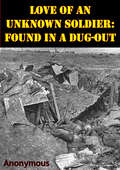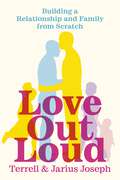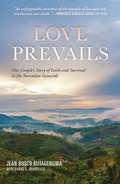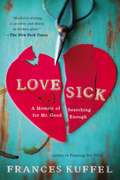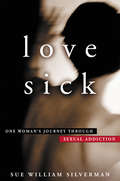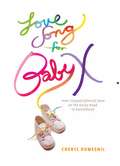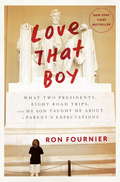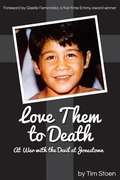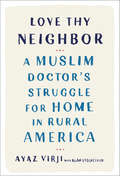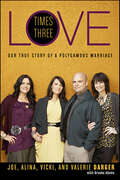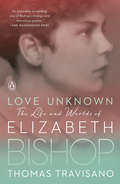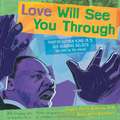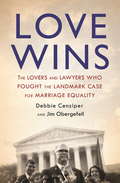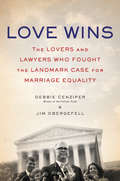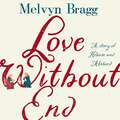- Table View
- List View
Love My Rifle More Than You: Young and Female in the U.S. Army
by Michael E. Staub Kayla Williams"A woman soldier has to toughen herself up," writes Kayla Williams in this fiercely honest account of what it's like to be part of the female 15 percent of today's Army. "Not just for the enemy, for battle, for death. I mean to toughen herself to spend months awash in a sea of nervy, hyped-up guys " Irreverent, vulnerable, angry, and humane, Williams describes what it's like for a young woman to be surrounded by an ocean of testosterone, respected for her skills and qualifications but treated variously as a soldier, a sister, a mother, a bitch, and a slut. During her five years of service -- including a year of deployment to Iraq during and after the invasionWilliams and her female peers navigate both extreme physical danger and emotional minefields. As a specialist in Military Intelligence, fluent in Arabic language skills, Williams finds herself at the forefront of the troops' interaction with local people. Brave and patriotic, with a strong sense of duty to her country and her fellow soldiers, +
Love My Rifle More than You: Young and Female in the U.S. Army
by Michael E. Staub Kayla Williams"Brave, honest, and necessary."--Nancy Pearl, NPR Seattle Kayla Williams is one of the 15 percent of the U.S. Army that is female, and she is a great storyteller. With a voice that is "funny, frank and full of gritty details" (New York Daily News), she tells of enlisting under Clinton; of learning Arabic; of the sense of duty that fractured her relationships; of being surrounded by bravery and bigotry, sexism and fear; of seeing 9/11 on Al-Jazeera; and of knowing she would be going to war. With a passion that makes her memoir "nearly impossible to put down" (Buffalo News) Williams shares the powerful gamut of her experiences in Iraq, from caring for a wounded civilian to aiming a rifle at a child. Angry at the bureaucracy and the conflicting messages of today's military, Williams offers us "a raw, unadulterated look at war" (San Antonio Express News) and at the U.S. Army. And she gives us a woman's story of empowerment and self-discovery.
Love Of An Unknown Soldier: Found In A Dug-Out [Illustrated Edition]
by AnonymousIncludes the First World War Illustrations Pack - 73 battle plans and diagrams and 198 photos'I think of you, as I shall think of you to the end, if the end comes. I do not want you less. I want you more perhaps, only not so selfishly. I realize that death does not finish all things. Love lives on. There are other worlds--there must be so many other worlds--in which I shall surely meet you if I miss you in this one. That I, so poor and human and puny, should be capable of this largeness of spirit, gives me confidence that God's scheme for us must be greater than we have guessed. He cannot be smaller than the souls He has created. You may not need me in this existence. We may have met too late to be much to each other. But I cannot think love is wasted.'The Love of an Unknown Soldier collects the intimate letters written by an anonymous World War I officer in Paris to his American love. Found by a young British soldier at the end of the war, the documents had been wedged in the wall of an abandoned gun dug-out, secreted away, and never mailed by the original author. There was no indication of the name or unit of the writer, presumed dead, nor did he mention the name of the girl he loved so dearly. Since tracing the letters' owner proved impossible, the young officer sent them to the publisher John Lane in an attempt to bring the letters to the attention of the American woman for whom the letters were written. The lady was never found, however, and the romantic soldier remains a mystery today.First published in 1916, this touching correspondence provides a clear depiction of the emotional realities and devastation of war.'- Print ed.
Love Out Loud: Building a Relationship and Family from Scratch
by Jarius Joseph Terrell JosephThe Root's June Books by Black Authors We Can't Wait to ReadRolling Out's Must-Read Books for June by Black AuthorsLGBTQ+ influencers Terrell and Jarius open up about their joyful love story and family life—and the challenges they've encountered along the way—in this honest, powerful guidebook. Terrell and Jarius Joseph—a picturesque home, adorable children, family businesses, and millions of fans online. Love Out Loud is Terrell and Jarius&’s guide to help couples of all kinds sustain their relationship and nurture their nontraditional family. With the Josephs&’s essential roadmap you&’ll learn how to: Define your needs as individuals and as a couple to build the life of your dreams Recognize growing pains before they hurt your marriage Break tradition to discover your unique parenting style Build a circle of support for your children We all crave genuine love, belonging, and the freedom to be our true selves, no matter what our family unit looks like. Love Out Loud is the story of the Josephs&’ quest to redefine fatherhood. After enduring a devastating miscarriage followed by two premature births by surrogacy just five weeks apart, Terrell and Jarius realized that to have the family of their dreams, they needed to live and love by their own rules. Filled with empathetic advice and a healthy dose of real talk, you, too, can discover how to build a relationship and family your way and build the life of your dreams.
Love Prevails: One Couple's Story of Faith and Survival in the Rwandan Genocide
by Jean Bosco RutagengwaTwenty-five years ago in April 1994, a savage campaign of genocide was unleashed against the Tutsis of Rwanda. In the space of one hundred days, one million people were left dead. This personal narrative tells the story of two survivors--Jean Bosco and his fiancée Christine. While most of their family members perished, they found refuge in what later become famous as the “Hotel Rwanda.” Their story of survival is at once a love story and a harrowing inside look at what happens when a country is overrun by evil. But it is also a story of faith--an effort to find God in the midst of horror--and of the subsequent struggle to find meaning, healing, and reconciliation.
Love Shrinks: A Memoir of a Marriage Counselor's Divorce
by Sharyn WolfFor twenty years, Sharyn Wolf, a practicing psychotherapist and "relationship expert," has helped revitalize the marriages of countless couples. But while she was being interviewed on Oprah and 48 hours to talk about her nationally bestselling books that instructed millions on how to flirt, find mates, and "stay lovers for life," she was going home every night to a dark secret: a totally failed marriage of her own to a good man she just couldn't leave.In Love Shrinks, Sharyn tells the mindbending--and yet deeply relatable--story of her (third!) marriage. In anecdotes that range from poignant to horrifying to side-splittingly funny to heart-rending, she explains how it is possible for two good people to make each other totally miserable and yet still be unable to leave. In fifteen years of marriage, she and her husband had sex twice. Despite the fact that Sharyn was a national bestselling self-help author, her husband couldn't bring himself to read a single one of her books. Communication between them had failed so utterly that the simple domestic activity of buying a couch together escalated to disastrous proportions. Yet through it all, they stay together--even though neither one knows why. Sharyn ends each chapter with a touching story of why she could never bear to leave this man who made her so unhappy. Painted against the backdrop of her psycotherapy practice, real-life illustrative cases of her patients, and the wacky story of career trajectory, Sharyn turns her analytical eye on herself and her husband and deftly depicts a marriage on its long last legs. The result is this beautiful and sad tapestry of a hidden and omnipresent human condition. You will not be able to put her book down.
Love Sick
by Frances KuffelFrances Kuffel wasn't a Victoria's Secret model, but she wasn't so bad. Why couldn't she find her Mr. Right? As Shakespeare said, the course of true love never did run smooth, but for Kuffel, it seemed like one pothole after another... In this sharp and irreverent memoir, Frances Kuffel recalls her quest to replace her on-again, off-again lover with someone new and preferably less unstable. Fifty-three and never married, Frances opens her mind to all possibilities. She goes out with an Orthodox Jew, is almost the victim of a scammer, stays out all night with a man twenty years her junior, encounters feeding fetishes and shoe fetishes, and generally reads a lot of strange emails. Brazenly honest and insightful, Kuffel comes through the experience with a new understanding of love and realizes that what she wants is not necessarily a knight in shining armor. She'd be perfectly happy with someone who'll spend hours buying antique teacups with her, thinks two dogs are not enough, and wants to be in her life through the good and the bad. And once she finally figures out what she's looking for, the only challenge left is to find it...
Love Sick: One Woman's Journey through Sexual Addiction
by Sue William SilvermanNow a Lifetime Television original movie airing April 2008 with Sally Pressman, star of Army Wives. In this powerful memoir, a woman learns to value herself--as a whole person rather than as a sexual object. Sue William Silverman tells of her roller-coaster life of sex and self-destructive behavior. Finally, addicted to danger itself, she seeks the help of a trusted therapist to discover what love really means.
Love Song For Baby X
by Cheryl DumesnilLove Song for Baby X is the moving and humorous story of a lesbian couple's struggles with infertility as they attempt to become parents, set against the backdrop of the marriage equality movement. While poet Cheryl Dumesnil suspects she'll confront some formidable obstacles on her path to parenthood, she is nevertheless unprepared for what she actually encounters, including navigating the maze of the high-tech fertility business, the emotional conundrum of pregnancy loss, and the gathering steam of the marriage equality movement. Love Song for Baby X follows Cheryl and her unlawfully wedded wife through four conceptions, three miscarriages, a temporarily legal wedding during San Francisco's Winter of Love in 2004, a stint as poster children for the marriage equality movement, and finally the arrival of their longed-for son--after twenty-five hours of labor. Along the way Dumesnil fails often (and comically) in her attempts to cultivate inner peace. Though she struggles mightily with the opposing forces of hope and fear, in the end, she finds the middle ground between them: acceptance. Winner of the 2008 Agnes Lynch Starrett Poetry Prize, Cheryl Dumesnil is the author of In Praise of Falling, editor of Hitched! Wedding Stories from San Francisco City Hall, and co-editor, with Kim Addonizio, of Dorothy Parker's Elbow: Tattoos on Writers, Writers on Tattoos. Her poems have appeared in Nimrod, Indiana Review, Calyx, and Many Mountains Moving, among other literary magazines. Her essays have appeared on literarymama.com, hipmama.com, mamazine.com, and in Hip Mama Zine. She lives in the San Francisco Bay Area with her wife and their two sons.
Love Style Life
by Garance Dore"The guardian of all style" (The New York Times Magazine) shares stories on life, love, style, and career, from Paris to New York, and inspires readers to cultivate an effortless chic that is all their own. Garance Doré, the voice and vision behind her eponymous blog, has captivated millions of readers worldwide with her fresh and appealing approach to style through storytelling. This gorgeously illustrated book takes readers on a unique narrative journey that blends Garance's inimitable photography and illustrations with the candid, hard-won wisdom drawn from her life and her travels. Infused with her Left Bank sensibility, the eclecticism of her adopted city of New York, and the wild, passionate spirit of her native Corsica, Love Style Life is a backstage pass behind fashion's frontlines, peppered with French-girl-next-door wit and advice on everything from mixing J.Crew with Chanel, to falling in love, to pursuing a life and career that is the perfect reflection of you.
Love That Boy: What Two Presidents, Eight Road Trips, and My Son Taught Me About a Parent's Expectations
by Ron Fournier<P>Tyler and I inch toward the Green Room, in line with blow-dried TV anchors and stuffy columnists. He's practicing his handshake and hello: <br>"It's a pleasure to meet you, Mr. President. It's a pleasure to meet you, Mr. President. It's a pleasure to meet you, Mr. President." <P>When the couple in front of us steps forward for their picture, my teenager with sky-blue eyes and a soft heart looks up at me and says, <br>"I hope I don't let you down, Dad." <P>What kind of father raises a son to worry about embarrassing his dad? I want to tell Tyler not to worry, that he'd never let me down. That there's nothing wrong with being different. That I actually am proud of what makes him special. But we are next in line to meet the president of the United States in a room filled with fellow strivers, and all I can think about is the real possibility that Tyler might embarrass himself. Or, God forbid, me.<P><P> LOVE THAT BOY is a uniquely personal story about the causes and costs of outsized parental expectations. What we want for our children--popularity, normalcy, achievement, genius--and what they truly need--grit, empathy, character--are explored by National Journal's Ron Fournier, who weaves his extraordinary journey to acceptance around the latest research on childhood development and stories of other loving-but-struggling parents. <P><b>A New York Times Bestseller</b>
Love Them to Death: At War with the Devil at Jonestown
by Timothy Stoen"Love Them to Death" is a memoir of my experiences as the attorney, enemy, and postmortem target of James Warren Jones who, on November 18, 1978 in Jonestown, Guyana, unleashed—in the name of "love"—terror and death. It tells how this ordinary man, Jim Jones, having captured the souls of kind and decent people, got them to assassinate a US congressman and, incredibly, got them—by the hundreds—to kill themselves and their children. "The mass suicides and murders in Jonestown, Guyana," said pollster George Gallup, "was the most widely followed event of 1978." By then Jim Jones had become a "Molotov cocktail." The container was Jones's absolute power. The flammable liquid was Jones's malignant narcissism. The wick was Jones's genius for mind control. In the end Jim Jones was nothing but evil. "The CIA would have had to acknowledge," said Stanford psychology professor Philip Zimbardo, "that Jones succeeded where their MK-Ultra program failed in the ultimate control of the human mind." On January 1, 1970, I joined a utopian movement called Peoples Temple, in order to pursue "Biblical socialism" (Acts 2). I became the pro bono lawyer for Jones for 7 years. Jim Jones eventually became what the "Washington Post" called a "West Coast Power," with a remarkable gift for wining over the most sophisticated people in politics. On November 18, 1977, I testified in court and went to war against Jones. By then, he had moved to Jonestown. I turned on Jones because I'd learned he was denigrating to a five-year-old child, John Victor Stoen then in Jonestown, his mother, Grace. During that one-year war for John Victor, I made two trips to the then “wired” country of Guyana, and in California I braced, every time the doorbell rang, for a shot to the chest. Finally, on that November 18th, the journey took a petrifying turn. Jim Jones killed 907 of his people by cyanide, and orchestrated the deaths, by gunfire at the nearby airstrip, of US congressman Leo Ryan and four others. Among those he took out by the poison was six-year-old John Victor Stoen. Structurally, this book traces the “development” of Jim Jones, as I experienced it from 1967 through 1979, through fourteen stages. On the day he died, Jim Jones exhorted his followers to "see that Stoen does not get by with this infamy." I was accused--falsely, I might add--of manipulating the 1975 San Francisco mayoral election, won by George Moscone over John Barbagelata, and then arranging to become special voter fraud prosecutor to cover up my crime. On that same day Jones made a prophecy: "We win when we go down. Tim Stoen has nobody else to hate... Then he'll destroy himself." It took nine years to undermine that curse. I have three reasons for writing this book. The first is to encourage healthy suspicion of authoritarian power. I want to show how leaders are corrupted by absolute power, and how they use charisma and demagogic oratory to acquire that power. The second reason is to encourage realistic approaches to fighting evil. I want to give evidence for psychiatrist Scott Peck’s position that evil people can be dealt with only by “raw power." My third reason is to give hope to people who, like me, have made huge mistakes in their lives. Recovery is possible. After all of my unbelievable mistakes, it is a miracle that I should now find myself alive, sane, and vital. It is truly due to something outside my control.
Love Thy Neighbor: A Muslim Doctor's Struggle for Home in Rural America
by Alan Eisenstock Ayaz VirjiA powerful true story about a Muslim doctor's service to small-town America and the hope of overcoming our country's climate of hostility and fear.In 2013, Ayaz Virji left a comfortable job at an East Coast hospital and moved to a town of 1,400 in Minnesota, feeling called to address the shortage of doctors in rural America. But in 2016, this decision was tested when the reliably blue, working-class county swung for Donald Trump. Virji watched in horror as his children faced anti-Muslim remarks at school and some of his most loyal patients began questioning whether he belonged in the community. Virji wanted out. But in 2017, just as he was lining up a job in Dubai, a local pastor invited him to speak at her church and address misconceptions about what Muslims practice and believe. That invitation has grown into a well-attended lecture series that has changed hearts and minds across the state, while giving Virji a new vocation that he never would have expected. In Love Thy Neighbor, Virji relates this story in a gripping, unforgettable narrative that shows the human consequences of our toxic politics, the power of faith and personal conviction, and the potential for a renewal of understanding in America's heartland.
Love Times Three: Our True Story of a Polygamous Marriage
by Joe Darger Vicki Darger Valerie Darger Alina DargerFrom a familythat inspired Big Love’s story of Bill Henricksonand his three wives, this first-ever memoir of a polygamous family captures theextraordinary workings of a unique family dynamic, and argues forthe acceptance of plural marriage as an alternative lifestyle. Readers ofCarolyn Jessop’s Escape, Elissa Wall’s StolenInnocence,and James McGreevey’s Confession,as well as fans of shows like Big Love and Sister Wives, will beenthralled by the first groundbreaking book in praise of polygamy.
Love Unknown: The Life and Worlds of Elizabeth Bishop
by Thomas TravisanoAn illuminating new biography of one of the greatest American poets of the twentieth century, Elizabeth Bishop"Love Unknown points movingly to the many relationships that moored Bishop, keeping her together even as life—and her own self-destructive tendencies—threatened to split her apart.&” —The Wall Street Journal Elizabeth Bishop's friend James Merrill once observed that "Elizabeth had more talent for life—and for poetry—than anyone else I've known." This new biography reveals just how she learned to marry her talent for life with her talent for writing in order to create a brilliant array of poems, prose, and letters—a remarkable body of work that would make her one of America's most beloved and celebrated poets. In Love Unknown, Thomas Travisano, founding president of the Elizabeth Bishop Society, tells the story of the famous poet and traveler's life. Bishop moved through extraordinary mid-twentieth century worlds with relationships among an extensive international array of literati, visual artists, musicians, scholars, and politicians—along with a cosmopolitan gay underground that was then nearly invisible to the dominant culture. Drawing on fresh interviews and newly discovered manuscript materials, Travisano illuminates that the "art of losing" that Bishop celebrated with such poignant irony in her poem, "One Art," perhaps her most famous, was linked in equal part to an "art of finding," that Bishop's art and life was devoted to the sort of encounters and epiphanies that so often appear in her work.
Love Until Death: The twisted true story of killer conman Alexandre Despallières
by Chris Hutchins‘Who is Alex? Is he the gifted businessman whose interests have netted him billions of dollars, whose generosity and charm has beguiled the world’s elite? Or is he the cold-blooded killer accused by the French police of poisoning his lover? A ruthless but brilliant conman who made millions by creating a fictitious persona?’Alexandre Despallières bewitched everyone he met with his disarming good looks and killer charm. But this had tragic consequences for many he got close to, as he left a trail of suspicious deaths in his wake.Posing as a billionaire businessman dying of an inoperable brain tumour, Despallières seduced and married music industry legend Peter Ikin in 2008. Just one month later, Ikin died of a paracetamol overdose and Despallières was set to inherit his estate, worth millions, through a forged will.As investigations unfolded, other suspected victims emerged, including Despallières’s own parents. Others narrowly managed to escape a similar fate, such as a Hollywood heiress, who Despallières convinced to adopt him, and conned her out of hundreds of thousands of dollars.Despallières died in 2022, just before he was due to stand trial, leaving unanswered questions behind. In Love Until Death, Chris Hutchins untangles Despallières’s web of deceit, and gains the trust of Despallières himself, who reveals his version of events for the first time.
Love Warrior
by Glennon Doyle MeltonThe Newest Oprah's Bookclub 2016 Selection<P><P> The highly anticipated new memoir by bestselling author Glennon Doyle Melton tells the story of her journey of self-discovery after the implosion of her marriage.<P> Just when Glennon Doyle Melton was beginning to feel she had it all figured out―three happy children, a doting spouse, and a writing career so successful that her first book catapulted to the top of the New York Times bestseller list―her husband revealed his infidelity and she was forced to realize that nothing was as it seemed. A recovering alcoholic and bulimic, Glennon found that rock bottom was a familiar place. In the midst of crisis, she knew to hold on to what she discovered in recovery: that her deepest pain has always held within it an invitation to a richer life.<P> Love Warrior is the story of one marriage, but it is also the story of the healing that is possible for any of us when we refuse to settle for good enough and begin to face pain and love head-on. This astonishing memoir reveals how our ideals of masculinity and femininity can make it impossible for a man and a woman to truly know one another - and it captures the beauty that unfolds when one couple commits to unlearning everything they've been taught so that they can finally, after thirteen years of marriage, commit to living true―true to themselves and to each other. <P> Love Warrior is a gorgeous and inspiring account of how we are born to be warriors: strong, powerful, and brave; able to confront the pain and claim the love that exists for us all. This chronicle of a beautiful, brutal journey speaks to anyone who yearns for deeper, truer relationships and a more abundant, authentic life.
Love Warrior (Oprah's Book Club): from the #1 bestselling author of UNTAMED
by Glennon DoyleWHAT CAME BEFORE HER NEW #1 BESTSELLER UNTAMED ...'IT'S AS IF SHE REACHED INTO HER HEART, CAPTURED THE RAW EMOTIONS THERE, AND TRANSLATED THEM INTO WORDS THAT ANYONE WHO'S EVER KNOWN PAIN OR SHAME CAN RELATE TO' OPRAH WINFREY, Oprah's Book Club 'EPIC' ELIZABETH GILBERT | 'BLEW ME AWAY' BRENÉ BROWN ... Just when Glennon Doyle was beginning to feel she had it all figured out - three happy children, a doting spouse, and a writing career so successful that her first book catapulted to the top of the New York Times bestseller list - her husband revealed his infidelity and she was forced to realize that nothing was as it seemed. A recovering alcoholic and bulimic, rock bottom was a familiar place to Glennon. In the midst of crisis, she knew to hold on to what she discovered in recovery: that her deepest pain has always held within it an invitation to a richer life. Love Warrior is the story of one marriage, but it is also the story of the healing that is possible for any of us when we refuse to settle for good enough and begin to face pain and love head-on. Love Warrior is a gorgeous and inspiring tale of how we are born to be warriors: strong, powerful, and brave; able to confront the pain and claim the love that exists for us all. This chronicle of a beautiful, brutal journey speaks to anyone who yearns for deeper, truer relationships and a more abundant, authentic life.AN OPRAH BOOK CLUB SELECTION
Love Will See You Through: Martin Luther King Jr.'s Six Guiding Beliefs (Into Reading, Trade Book #4)
by Sally Comport Angela WatkinsNIMAC-sourced textbook <P><P>The niece of Martin Luther King, Jr. reveals six timeless and universal principles that encompass the civil rights leader’s greatest legacy: Love will see you through. <P><P>Growing up as the niece of Martin Luther King Jr., Angela Farris Watkins witnessed firsthand the principles and values that “Uncle M.L.” practiced and lived by throughout his fight for equality. Drawing from experiences and episodes both personal and well-known, Dr. Watkins artfully details the guiding beliefs of one of the greatest men in history. Including “have courage” and “love your enemies,” these six hallmarks of virtue and nonviolence reinforce the truth that “the universe honors love” and will inspire readers of all ages.
Love Wins
by Jim Obergefell Debbie CenziperIf you've ever thought to yourself "I can't possibly win against these odds", this is a story for you. This book will become a classic.' - ERIN BROCKOVICHLove Wins is the love story behind the David and Goliath battle that won the most important American civil rights victory in decades - and inspired the rest of the world.More than twenty years ago, Jim Obergefell and John Arthur fell in love in Cincinnati, Ohio, a place where gays were routinely picked up by police and fired from their jobs. In 2013 Jim and John - who was dying of the crippling neurodegenerative disease Amyotrophic Lateral Sclerosis - flew to Maryland, where same-sex marriage was legal, and exchanged vows on the tarmac. But back home, Ohio refused to recognise their union. John's death certificate would describe him as single and Jim would not only have to mourn his partner but also be denied acknowledgment of the life they had shared.Then they met lawyer Al Gerhardstein, who had spent nearly three decades advocating for civil rights, and who now saw an opening that had never been explored in the courtroom. Together Al and Jim began a long and gruelling battle against overwhelming odds, partnering with more than fifty lawyers and plaintiffs to make their case. In 2015 the Supreme Court ruled in their favour, making same-sex marriage the law of the land in a decision as groundbreaking as Roe v Wade.At its heart, Love Wins is the ultimate love story - about a man who goes to such lengths to fulfil a promise to the love of his life that he ends up changing the world. Part Erin Brockovich, part Philadelphia, this story will inspire readers for generations to come.
Love Wins: For Teens
by Rob BellIf God were throwing a party, would everyone be invited? Or does God invite some and not others? And if so, how does God decide? Is it what you say? Is it what you do? Is it what you're going to do? Is it who your friends are? Or what your friends do? Or what religion you happened to be born into? Or where you live, or what you look like, or what you believe? What if the idea of heaven and hell that we have been taught is not, in fact, what the Bible teaches? What if Jesus meant something very different by the concepts of heaven, hell, and salvation from how we've come to understand them? And what if the answer to life's meaning is much better than we ever imagined? In his teen edition of the bestselling book love wins, Rob Bell tackles all these questions in a way that addresses the real challenges of growing up in today's world. This is not just a book of questions and this is not just a book of answers. This is a book of exploration. This is a book of discovery. This is a book about why love wins.
Love Wins: The Lovers and Lawyers Who Fought the Landmark Case for Marriage Equality
by Jim Obergefell Debbie CenziperTwenty-one years ago when Jim Obergefell walked into a bar in Cincinnatti and sat down next to John Arthur, the man who would become the love of his life, he had no way of knowing that following the sad loss of John to Motor Neurone Disease his fight to have their marriage recognised on John's death certificate would lead him from the courthouses of Cincinnati to the steps of the U.S. Supreme Court and ultimately into the history books. Jim Obergefell is representative of the 32 plaintiffs in the case "Obergefell v Hodges", arguably the biggest civil rights case of our time, which in June this year saw same-sex marriage recognised across every US state. Here Jim teams up with long-time friend and Pulitzer Prize-winning journalist Debbie Cenziper of The Washington Post to tell his story.LOVE WINS is a legal thriller and love story focused on ordinary people in game-changing circumstances, part Erin Brockovich, part Milk, part Still Alice. It is a story about marriage, grief, courage and the law, but mostly it's about a promise made to a dying man who needed to know that he would be remembered. Through insider accounts and access to key players, LOVE WINS will reveal the dramatic and previously unreported events behind the Supreme Court case that bears Jim's name. The poignant narrative will chronicle how a grieving man and his small-town lawyer, confronted with overwhelming legal, political and personal setbacks, won the most important gay rights case in U.S. history.
Love Wins: The Lovers and Lawyers Who Fought the Landmark Case for Marriage Equality
by Jim Obergefell Debbie CenziperThe fascinating and very moving story of the lovers, lawyers, judges and activists behind the groundbreaking Supreme Court case that led to one of the most important, national civil rights victories in decades—the legalization of same-sex marriage.In June 2015, the Supreme Court made same-sex marriage the law in all fifty states in a decision as groundbreaking as Roe v Wade and Brown v Board of Education. Through insider accounts and access to key players, this definitive account reveals the dramatic and previously unreported events behind Obergefell v Hodges and the lives at its center. This is a story of law and love—and a promise made to a dying man who wanted to know how he would be remembered.Twenty years ago, Jim Obergefell and John Arthur fell in love in Cincinnati, Ohio, a place where gays were routinely picked up by police and fired from their jobs. In 2013, the Supreme Court ruled that the federal government had to provide married gay couples all the benefits offered to straight couples. Jim and John—who was dying from ALS—flew to Maryland, where same-sex marriage was legal. But back home, Ohio refused to recognize their union, or even list Jim’s name on John’s death certificate. Then they met Al Gerhardstein, a courageous attorney who had spent nearly three decades advocating for civil rights and who now saw an opening for the cause that few others had before him.This forceful and deeply affecting narrative—Part Erin Brockovich, part Milk, part Still Alice—chronicles how this grieving man and his lawyer, against overwhelming odds, introduced the most important gay rights case in U.S. history. It is an urgent and unforgettable account that will inspire readers for many years to come.
Love Without Borders: How Bold Faith Opens the Door to Embracing the Unexpected
by Angela BraniffFrom the founder of This Gathered Nest YouTube channel, an uplifting story of Angela Braniff's unusual path to becoming the mother to seven children through various methods of adoption and biological approaches, encouraging women and mothers to embrace the unique purpose that God has put in their lives.Angela’s love for life and her family radiates through everything she does. The Braniff household includes their two biological daughters, Kennedy, 12, and Shelby 10; Rosie, 7, who was adopted from China with Down syndrome; Noah, 7, adopted from Congo; Jonah 5, adopted domestically; and finally, Ivy and Amelia, their one year old twins who were adopted as embryos, and implanted in Angela, who gave birth to them. In fact, after the book was finished, they joyfully welcomed a new baby into their home, Benjamin, through adoption, making them now a family of ten!Love Without Borders shares Angela's relatable, humorous, and honest view of motherhood. Angela chronicles her journey to discover God’s purpose for her life. For years she walked the safe, expected path, until one day she could feel God calling her to boldly step out and follow him into new places, which led her to raise a large, non-traditional family that looked different than she ever imagined. It was a winding path to motherhood, complete with heartbreak from failed adoptions, challenging pregnancies, and secondary infertility, but through it all Angela found the unique adventure God had for her. She has shared her family’s stories on her popular YouTube channel, This Gathered Nest, and now invites us in to go deeper and listen to where God might be calling us to go and who we’ve been tasked with loving, no matter how unusual (or just plain crazy) it may sound! The beauty of God’s plan is he uses imperfect people to bring about perfectly beautiful stories.
Love Without End: A Story of Heloise and Abelard
by Melvyn BraggA profoundly thought-provoking, moving novel that breathes fresh life into one of history's most remarkable and enduring love stories. Paris in 1117. Heloise, a brilliant young scholar, is astonished when the famous, radical philosopher, Peter Abelard, consents to be her tutor. But what starts out as a meeting of minds turns into a passionate, dangerous love affair, which incurs terrible retribution. Nine centuries later, Arthur is in Paris to recreate the extraordinary story of Heloise and Abelard in a novel. To his surprise, his daughter visits and agrees to help, challenging his portraits of a couple who seem often inscrutable, sometimes breathtakingly modern. It soon emerges she is on her own mission to discover more about her parents' fractured relationship - and that Arthur's connection to his subject is more emotional than he cares to admit.(P)2019 Hodder & Stoughton Limited


